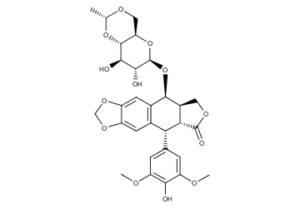Etoposide CAS NO 33419-42-0 Inquire about Etoposide
Tecoland supplies Etoposide bulk active pharmaceutical ingredient (API) to the pharmaceutical industry. Our Etoposide is manufactured by cGMP compliant facility. Welcome to contact us for further details including current DMF status for the product and up to date regulatory status of the manufacturing facility. We look forward to assisting you with your research and development projects.
What is Etoposide?
Etoposide phosphate (brand names: Eposin, Etopophos, Vepesid, VP-16) is an anticancer agent. It is known in the laboratory as a topoisomerase inhibitor. It exploits the normal mechanism of action of the enzyme topoisomerase II, which aids in DNA unwinding, and by doing so causes DNA strands to break. Cancer cells rely on this enzyme more than healthy cells, since they divide more rapidly. It is used as a form of chemotherapy for cancers such as Ewing’s sarcoma, lung cancer, testicular cancer, lymphoma, nonlymphocytic leukemia, and glioblastoma multiforme. It is often given in combination with other drugs. It is also sometimes used in a conditioning regimen prior to a bone marrow or blood stem cell transplant.
Its chemical make-up derives from podophyllotoxin, a toxin found in the American Mayapple.
The name VP-16 likely comes from a compounding of the last name of the chemists who performed early work on the drug (von Wartburg and von Kuhn) and podophyllotoxin. Another scientist who was integral in the development of podophyllotoxin-based chemotherapeutics was the medical pharmacologist Hartmann F. Stähelin.
Mechanism of Action
Etoposide forms a ternary complex with DNA and the topoisomerase II enzyme, preventing re-ligation of the DNA strands. This causes errors in DNA synthesis and promotes apoptosis of the cancer cell.
Administration
It is given intravenously or orally in capsule form. If the drug is given by IV, it must be done slowly over a 30- to 60-minute period because it can lower blood pressure as it is being administered. Blood pressure is checked often during infusing, with the speed of administration adjusted accordingly.
In general, patients are advised to call their doctor in case of fever, symptoms of infection, or painful injection sites, as these may progress severely without adequate medical attention.
Patients are advised to drink large amounts of fluids after treatment to prevent damage to the bladder and kidneys, typically 1.5 to 3.5 liters of water on the day of treatment and for several days after.
Disclaimer:
Information on this page is provided for general information purposes. You should not make a clinical treatment decision based on information contained in this page without consulting other references including the package insert of the drug, textbooks and where relevant, expert opinion. We cannot be held responsible for any errors you make in administering drugs mentioned on this page, nor for use of any erroneous information contained on this page.